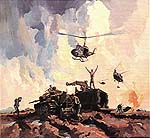Recovery in The Field - 1944
WO K.A. [Sandy] Tocock,mid - Recovery

Sandy Tocock
When I transferred to RAEME from the British Army in the early 1950s, I had with me a special issue of the British Machine Tool Engineering, Jan-Feb-Mar 1944. Its 114 pages were devoted to the then new Corps of REME, its organization, operation and techniques. The foreword was written by the first Director of REME, Major General E.B. Rowcroft; available on this link
The section on Recovery in the Field covered Pages 7 to 17. They have been reproduced as web pages and may be viewed in the links below.
For those who are interested in or involved in the technical aspects of recovery, these pages will be very valuable. Throughout a long career, including as commander of an Armoured Recovery Vehicle on Operations, and later as a training specialist, these pages were a constant reference
British Machine Tool Engineering ... Jan-Feb-Mar 1944
Page Menu:
1
2
3
4
5
6
7
8
9
10
Page 8
Recovery and Transportation

Fig39 .. Recovering a Churchill tank from a crater
using a Diamond T tractor in conjunction with 40ton Dyson tank transporter ; the drawing shows the 3 to 1 layout used.

Fig40 .. The Churchill is drawn up on to the Dyson trailer by the tractor's winch.
Another method used for the recovery and transportation of Churchill tanks is the Diamond T 6 wheeled tractor in conjunction with a 40ton Dyson multi-wheeled trailer as shown in Fig39 which features the recovery of a tank from a crater.
As an approximate pull of 16 to 20ton is required to load dead Churchill tanks it is necessary to lay out a 3to1 reduction ratio with the tractor winch rope as depicted in the inset drawing on the photograph. A nearer view of the Churchill tank as it is drawn up on to the trailer is given in Fig40.


Fig41 .. A Covenanter tank is recovered from a pond and loaded onto a transporter; the drawing shows the layout and securing arrangements.
The next example shows the use of a 14 wheeled 30ton Scammell tank transporter for recovering and loading a damaged 20ton Covenanter tank from out of a pond (see Fig41).
The inclined platform of this type of transporter greatly assists the unloading of dead tanks; the loading ramps are also of the drawbridge type and can be raised or lowered by means of a hand winch and steel cable.
The method of loading, employing a 2to1 pull attached to a front loading yoke, is clearly illustrated in the inset drawing which also shows the arrangement for securing the tank in position (this sketch is not drawn to scale).
Page 8







